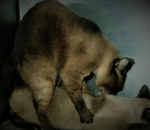Tick fever in cattle is also called with other names like Texas fever, Red fever, Splenic fever, Biliary fever, Babesiosis & Piroplasmosis. Tick fever is a haemoprotozoan infection of cattle, buffalo, horse, sheep, goat, dog, pig, wild animals, and occasionally people.
This disease is transmitted from affected to healthy animals through tick bites. Boophilus (Rhipicephalus) microplus and Boophilus (Rhipicephalus) annulatus are the major vectors of bovine babesiosis in the Asiatic region. Babesiosis is mainly transmitted by Rhipicephalus, Haemaphysalis, Dermacentor, and Ixodes ticks.
Babesia bigemina, Babesia bovis, Babesia divergens and Babesia major are the principal strains of cattle & buffalo.
Tick Fever Symptoms
- Fever (106 Farheneuit)
- Inappetence (anorexia)
- Depression & weakness
- Anemia & Jaundice
- Increased respitratory rate
- Muscle tremors (skeletal muscles)
- Weight loss
- Hemoglobinuria & Hemoglobinemia
- Either diarrhea or constipation may occur
- Pregnant Cows may abort
- B. bovis infection may involve the central nervous system leading to ataxia, paddling of limbs and coma.
Diagnosis
It is based on
- Clinical Signs & Symptoms (Haemoglobinuria is a cardinal sign)
- Examination of blood smear stained with giemsa stain (Simplest daignostic method)
- Clinical pathology: Low erythrocyte count, low packed cell volume, low haemoglobin level and increased blood cell sedimentation.
- Serological tests
- Capillary agglutination test
- Comlement fixation test (CFT)
- Radio immunoassay
- Enzyme linked immunosorbent assay (ELISA)
- Indirect haemagglutination test
- Indirect fluorescent antibody test
- Curd agglutination test
- Slide agglutination test
- Latex agglutination test
Tick Fever Treatment
- Diminazine aceturate 3.5mg/kg deep IM ,OR,
- Imidocarb dipropionate 1.2mg/kg SC ( @ 3 mg/kg, imidocarb provides protection from babesiosis for 4 wk and will also eliminate Babesia bovi and B. bigemina from carrier animals.)
- Anti-inflammatory drugs (analgesic antipyretic drugs for control of fever and abdomianl pain)
- Corticosteroids
- Fluid therpay
- Whole blood therapy to correct severe anemia (Severe cases).
Control
- Measures should be adopted to control the tick population as far as possible as it is a tick-borne disease.
- A herd can be made tcik free by dipping or spraying at periodical interval with acaricides
- By use of Vaccination protocols
Zoonotic Risk
A number of human cases of babesiosis have been recorded. In humans, this infection is acquired via bites from infected ticks or through the infected blood of a transfusion donor.


